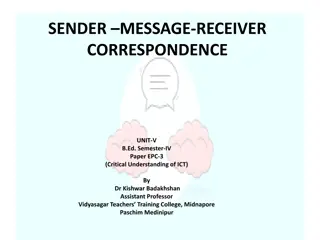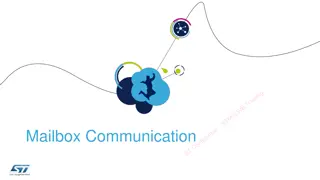Understanding the Process of Communication
Communication is a dynamic process involving the sending and receiving of messages through various means like verbal, non-verbal, visual, and audio methods. It is derived from the Latin term "Communis" meaning sharing and interaction. Effective communication requires encoding, decoding, and feedback to ensure clear understanding between individuals. This process is essential for conveying information and fostering understanding in personal and professional relationships.
Download Presentation

Please find below an Image/Link to download the presentation.
The content on the website is provided AS IS for your information and personal use only. It may not be sold, licensed, or shared on other websites without obtaining consent from the author. Download presentation by click this link. If you encounter any issues during the download, it is possible that the publisher has removed the file from their server.
E N D
Presentation Transcript
The Concept/ Process of Communication
The English word Communication is derived from the Latin term Communis Communis: to transmit, impart to make common sharing and interaction Communication is a dynamic process It involves a continuous sending and receiving of messages Messages may be conscious or unconscious, intentional or unintentional. Communication is a varied set of processes It uses different means such as verbal, non-verbal, visual, audio, audio-visual methods.
Definitions: Peter Little: Communication is the process by which information is passed between individuals and/or organisations by means of previously agreed symbols. Keith Davis: Communication is the transfer of information and understanding from one person to another.
The Communication Cycle/ Process Encoding/Decoding/Feedback Communication takes place with the help of symbols. A symbol is a sign which stands for an object or idea. When a set of symbols is agreed upon by two or more people we call it a code. All languages are codes of one kind or another. When a message is sent out in a code it is called encoding. When the code is translated and understood by the receiver, it is called decoding.
Public Decoded message Coded message Receiver decoder encoder signal Sender Encode message Decoded message Public
1. 2. 3. 4. Need for feedback 1. It helps us to understand and be understood. 2. It extends communication. 3. Increases accuracy and confidence. 4. Reduces doubt & hostility. Characteristics of Human Communication 1. The meaning of the message depends on the social and cultural situation, economic, political and personal context in which it is delivered. 2. Dynamic and ongoing, continuous process. 3. The elements or components of communication are inter-related or connected. 4. People communicate wholly and entirely. 5. Human communication requires a channel or medium. Feedback It is the reaction or response which is communicated to the sender Characteristics Feedback is obtained all the time Can be positive or negative Immediate or delayed Verbal or non-verbal
How to communicate effectively The basic principles of effective communication are: a) Communicate for a purpose: Define your objective and be clear about your purpose. b) Compose your message to sttract attention: i. intensity: forceful, loud, soft, gentle ii. avoid monotony iii. use repetition iv. systematic arrangement c) Remove all barriers to communication d) Study the receiver of your message e) Select your medium carefully f) Provide for feedback g) Act promptly on receiving feedback
Business Communication Business Communication is the link; the means of contact between members of an organisation and others. Koontz: Business Communication is a process which involves the transmission and accurate replication of ideas purporting to stimulate action to attain organizational goals. Characteristics Flow of communication is 1. vertical, horizontal 2. formal or informal 3. direct or indirect 4. Hierarchy and status influence the type of communication, nature of communication 5. Messages are reproduced serially 6. Democrartic- reaches out to all levels
Need and importance of Business Communication 1. Rapid globalisation: Business activities transcend boundaries so effective management required. More competition. 2. Specialisation: Professionals and experts have to convey their expertise to others. Help to solve organizational problems. 3. Prevent waste of time & money. Effective communication proves cost effective. Problems and how to overcome them 1. Time constraints 2. Conflicting goals 3. Difficult working conditions 4. Complex and controversial issues, etc.
1. Goals & objectives to be clearly stated 2. Receivers to be identified & well defined 3. Ideas & policies to be clearly outlined 4. Use suitable devices & techniques 5. Revise & evaluate
























